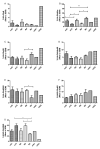Isolation and Characterization of Heparan Sulfate from Human Lung Tissues
- PMID: 34576979
- PMCID: PMC8469465
- DOI: 10.3390/molecules26185512
Isolation and Characterization of Heparan Sulfate from Human Lung Tissues
Abstract
Glycosaminoglycans are a class of linear, highly negatively charged, O-linked polysaccharides that are involved in many (patho)physiological processes. In vitro experimental investigations of such processes typically involve porcine-derived heparan sulfate (HS). Structural information about human, particularly organ-specific heparan sulfate, and how it compares with HS from other organisms, is very limited. In this study, heparan sulfate was isolated from human lung tissues derived from five donors and was characterized for their overall size distribution and disaccharide composition. The expression profiles of proteoglycans and HS-modifying enzymes was quantified in order to identify the major core proteins for HS. In addition, the binding affinities of human HS to two chemokines-CXCL8 and CCL2-were investigated, which represent important inflammatory mediators in lung pathologies. Our data revealed that syndecans are the predominant proteoglycan class in human lungs and that the disaccharide composition varies among individuals according to sex, age, and health stage (one of the donor lungs was accidentally discovered to contain a solid tumor). The compositional difference of the five human lung HS preparations affected chemokine binding affinities to various degrees, indicating selective immune cell responses depending on the relative chemokine-glycan affinities. This represents important new insights that could be translated into novel therapeutic concepts for individually treating lung immunological disorders via HS targets.
Keywords: chemokine/GAG interactions; chemokines; disaccharide composition; glycosaminoglycans; heparan sulfate; lung.
Conflict of interest statement
The authors declare no conflict of interest.
Figures




References
-
- Abramsson A., Kurup S., Busse M., Yamada S., Lindblom P., Schallmeiner E., Stenzel D., Sauvaget D., Ledin J., Ringvall M., et al. Defective N-sulfation of heparan sulfate proteoglycans limits PDGF-BB binding and pericyte recruitment in vascular development. Genes Dev. 2007;21:316–331. doi: 10.1101/gad.398207. - DOI - PMC - PubMed
MeSH terms
Substances
LinkOut - more resources
Full Text Sources

